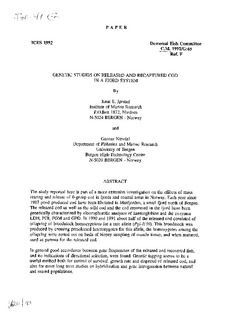Genetic studies on released and recaptured cod in a fjord system
Working paper
Permanent lenke
http://hdl.handle.net/11250/105066Utgivelsesdato
1992Metadata
Vis full innførselSamlinger
Originalversjon
This report is not to be cited without prior reference to the authorsSammendrag
The study reported here is part of a more extensive investigation on the effects of mass
rearing and release of 0-group cod in fjords and coastal areas in Norway. Each year since
1987 pond produced cod have been liberated in Masfjorden, a small fjord north of Bergen.
The released cod as well as the wild cod and the cod recovered in the fjord have been
genetically characterized by electrophoretic analyses of haemoglobins and the enzymes
LDH, PGI, PGM and GPD. In 1990 and 1991 about half of the released cod consisted of
offspring of broodstock homozygotous for a rare allele (Pgi-l ( 30). This broodstock was
produced by crossing preselected heterozygotes for this allele, the homozygotes among the
offspring were sorted out on basis of biopsy sampling of muscle tissue, and when matured,
used as parents for the released cod.
In general good accordance between gene frequencies of the released and recovered fish,
and no indications of directional selection, were found. Genetic tagging seems to be a
useful method both for control of survival, growth rate and dispersal of released cod, and
also for more long term studies on hybridization and gene introgression between natural
and reared populations.
